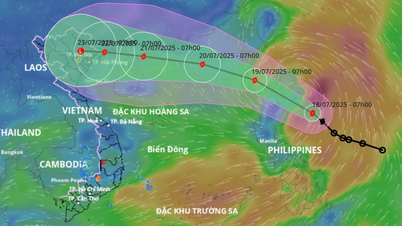There are currently no effective treatments for hemorrhagic stroke, which can easily lead to death and disability, but can be prevented by taking daily medication to control it, especially for people with high blood pressure.
Associate Professor, Dr. Nguyen Huy Thang, Vice President of the Vietnam Stroke Association and Head of the Department of Cerebrovascular Diseases at People's Hospital 115, said that there are two types of stroke: cerebral infarction (localized cerebral ischemia) and cerebral hemorrhage (cerebral bleeding). Cerebral infarction can be cured if you go to the hospital early in the first hours after the onset of symptoms, using methods such as using thrombolytic drugs and removing blood clots with mechanical devices.
Meanwhile, hemorrhagic stroke accounts for only about 15%, but so far there are not many effective treatments. Recently, some places have performed minimally invasive surgery for patients with cerebral hemorrhage who arrived at the hospital within 24 hours, with a hemorrhage volume of over 30 ml, but the recovery results are not as spectacular as those for cerebral infarction treatment.
Most patients with cerebral hemorrhage must be hospitalized for resuscitation, blood pressure control, and general support... to help prevent the size of the hematoma from increasing and reduce complications. The mortality rate of cerebral hemorrhage is up to 50% in the first three months, and the prognosis depends mainly on the size of the hematoma in the brain, large or small. Very few patients with mild cases can recover and walk on their own. Most patients face a life of permanent disability, able to perform personal activities but unable to return to their original job or must stay in bed and unable to take care of themselves.
According to Dr. Thang, the most common cause of cerebral hemorrhage is uncontrolled high blood pressure, only a few are due to cerebral vascular malformations. In particular, long-term high blood pressure causes blood vessels to become sclerotic, losing elasticity (like water pipes). High blood pressure increases pressure in small blood vessels deep in the brain, on the basis of long-term atherosclerosis will lead to rupture of blood vessels creating blood clots in the brain.
Preventing cerebral hemorrhage requires good blood pressure control. However, the danger today is that many Vietnamese people are very subjective about high blood pressure, most patients feel healthy so they neglect treatment. Even many patients with systolic blood pressure above 200 mmHg still feel normal health. Meanwhile, this disease requires long-term medication control, almost lifelong treatment.
Most of the patients with cerebral hemorrhage who come to People's Hospital 115 do not take their blood pressure medication as prescribed. There are people who have had high blood pressure, have been taking medication for several years, and when their blood pressure is stable, they stop taking the medication on their own, do not want to take medication all year round, or buy their own prescription drugs, or even only choose 1-2 types of drugs from the doctor's prescription to buy. There are also many people who, after being hospitalized for a stroke, only find out that they have high blood pressure.
On a global scale, cardiovascular disease is the leading cause of death. However, in about 40% of countries, stroke is the leading cause of death, higher than cardiovascular disease, including Vietnam and China. Vietnam is among the countries with the highest risk of stroke in the world , but the number of treatment facilities is still too small.
Doctors recommend that everyone should have regular health check-ups. If the main culprits that cause stroke in general such as high blood pressure, diabetes, atrial fibrillation... are detected, long-term medication should be used to control them. Avoid risk factors for stroke by stopping smoking, limiting alcohol, controlling weight, eating a balanced diet, and exercising regularly.
Go to the hospital immediately if you have any of the following symptoms: numbness or weakness in the face, arms or legs. Be careful if the symptoms occur on one side of the body, mouth distortion, sudden inability to speak or difficulty speaking, blurred vision, headache, dizziness, loss of balance.
Le Phuong
Source link





![[Video] More than 100 universities announce tuition fees for the 2025–2026 academic year](https://vphoto.vietnam.vn/thumb/1200x675/vietnam/resource/IMAGE/2025/7/18/7eacdc721552429494cf919b3a65b42e)
























































































![[Infographic] In 2025, 47 products will achieve national OCOP](https://vphoto.vietnam.vn/thumb/402x226/vietnam/resource/IMAGE/2025/7/16/5d672398b0744db3ab920e05db8e5b7d)





Comment (0)